“A need is something that solves an actual or imaginary problem, while a want is simply something that we’d like to have for whatever rational or irrational reason.” — JORGE BABA FROM GAME-CHANGER
When we start getting into a new project, we take a methodical approach to ensures that we are solving the right problems and have a more holistic view of the problem at hand. Digging up information from clients can be a little tricky. Many customers know what they need or want, but have trouble when expressing their thought. It’s tricky to tell what actually they really need vs. want.
So how do we know what the client needs rather than just their wants? We summarize a number of points to help you identify your client needs:
Gain Insights From Conversations
Request one on one conversation allow you to get a more comprehensive view of the challenges in their business. You need to do is gain some insight through conversation; This is the best thing to do to uncover client motivations. Cause many clients won’t differentiate themselves. Asking them with the right question to learn what they actually learn. Here are a few sample questions for your reference:
What is their long-term objectives?
Each project can be different and have unique objective. Asking them what are the specific long-term objectives. These objective are generally given by those who are responsible for the success of project.
What is the issue you want to solve?
Asking the client of what they are actually looking for. Be aware of what’s going wrong, because usually some of the clients only have a vague idea of what they need.
How much are they willing to spend?
Money matters to almost every client, but it can hard for them to recognize the benchmark price for the value of certain products/services.
For further questions reference, you can take a look the idea of questions you can ask your customer in here
Gather Information and Prioritize The Requirements
Gathering information could be done by several methods from Stakeholder interview, brainstorming, or simply by giving them questionnaires to fill out. The hardest part is gathering those different information from many desires of stakeholders. Some of these requests might not realistic or more expensive than the business benefit. The best way is to start by prioritizing requirements according to the priority of their parent objectives, and categorize which are a good to have and which are must have.
Map Your Client Journey
The client journey map is a visualization of the process a client goes through when engaging with a product or service. It takes process mapping to a new level by including multiple phases and touch-points a person goes through. It’s a document meant to unify fragmented efforts and identify points of friction and opportunities for improvement.
Finding and fixing the pain points in a customer’s journey isn’t just about damage control: It’s also about the innovation that comes from fixing the pain.
Understand Their Real Issue
"You’ve got to start with the customer experience and work backwards to the technology. You cannot start with the technology and try to figure out where you are going to sell it.” — STEVE JOBS
A client’s motivation to use/buy certain services/products is based on several possible factors: Do client favour particular brands over generic counterparts? Do they watch their money very, very carefully? Do they make choices based on impulsive or emotional needs, such as buying to keep up with the latest trends?
Getting to the root of these questions enables a company to promote what works and to do away with what isn’t as cost-efficient. Maximizing the number of things offered that suit what clients want is the key to lasting in business.
Key Points
To sum it up, here are a few key points to identify client needs that you can follow:
- To ensure customer satisfaction, you must correctly identify customers’ needs.
- To identify needs, you must both listen and ask the right questions.
- After identifying needs, always check for additional or related needs.
- Use your knowledge and experience to identify and present the right products, services, and solutions to meet your customers’ needs.
Rock Paper Scissors is the missing link between business and technical world. We translates business language into technical, and technical limitation into business constraints. We guide organization and individuals alike to create their own digital product and navigates all the complexity of product creation process. Find out more.
